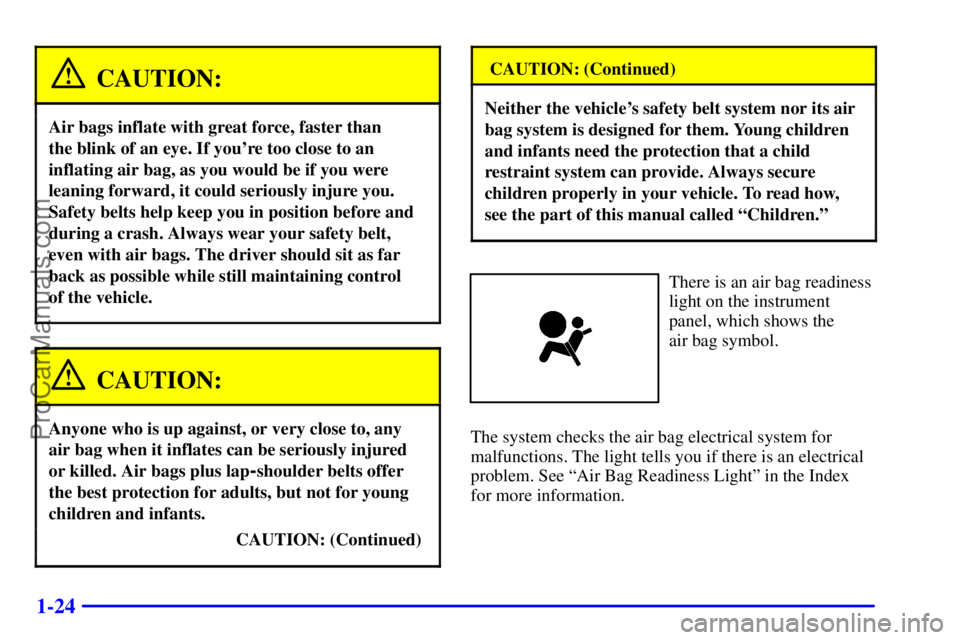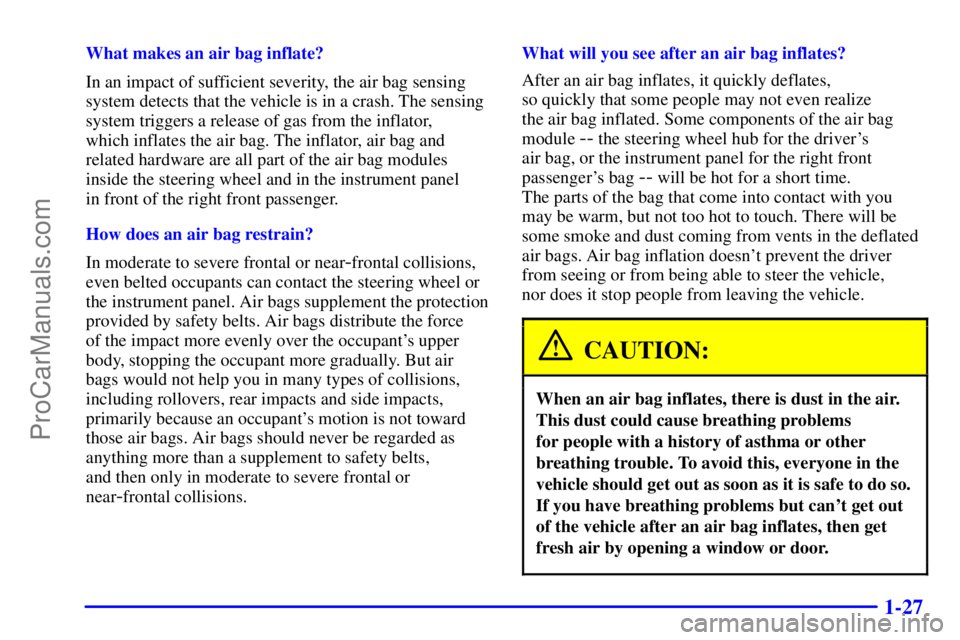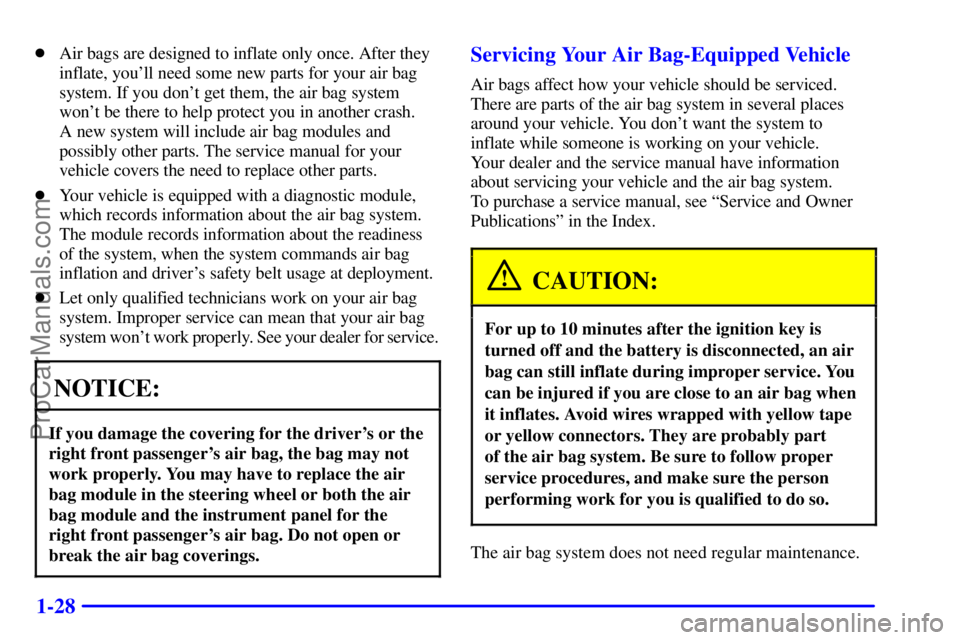Page 4 of 448
ii
Table of Contents
Windows
Keys and Door Locks
Remote Keyless Entry System (If Equipped)
Endgate/Liftgate
Automatic Transmission (If Equipped)
Manual Transmission (If Equipped)
Four-Wheel Drive (If Equipped)
Parking Brake
Tilt Wheel
Turn Signal/Multifunction Lever
Windshield WipersCruise Control
Exterior and Interior Lamps
Mirrors
Storage Compartments
Luggage Carrier (If Equipped)
Accessory Power Outlets
OnStar® System (If Equipped)
Sunroof (If Equipped)
HomeLink® Transmitter (If Equipped)
Instrument Panel, Warning Lights and Gages Seats and Seat Controls
Safety BeltsAir Bag Systems
Restraint Systems for Children
Section
1
Section
2
Seats and Restraint Systems
Features and Controls
ProCarManuals.com
Page 25 of 448
1-13
The person keeps going until stopped by something.
In a real vehicle, it could be the windshield ...or the instrument panel ...
ProCarManuals.com
Page 36 of 448

1-24
CAUTION:
Air bags inflate with great force, faster than
the blink of an eye. If you're too close to an
inflating air bag, as you would be if you were
leaning forward, it could seriously injure you.
Safety belts help keep you in position before and
during a crash. Always wear your safety belt,
even with air bags. The driver should sit as far
back as possible while still maintaining control
of the vehicle.
CAUTION:
Anyone who is up against, or very close to, any
air bag when it inflates can be seriously injured
or killed. Air bags plus lap
-shoulder belts offer
the best protection for adults, but not for young
children and infants.
CAUTION: (Continued)
CAUTION: (Continued)
Neither the vehicle's safety belt system nor its air
bag system is designed for them. Young children
and infants need the protection that a child
restraint system can provide. Always secure
children properly in your vehicle. To read how,
see the part of this manual called ªChildren.º
There is an air bag readiness
light on the instrument
panel, which shows the
air bag symbol.
The system checks the air bag electrical system for
malfunctions. The light tells you if there is an electrical
problem. See ªAir Bag Readiness Lightº in the Index
for more information.
ProCarManuals.com
Page 37 of 448
1-25 How the Air Bag System Works
Where are the air bags?
The driver's air bag is in the middle of the steering wheel.
The right front passenger's air bag is in the instrument
panel on the passenger's side.
ProCarManuals.com
Page 39 of 448

1-27
What makes an air bag inflate?
In an impact of sufficient severity, the air bag sensing
system detects that the vehicle is in a crash. The sensing
system triggers a release of gas from the inflator,
which inflates the air bag. The inflator, air bag and
related hardware are all part of the air bag modules
inside the steering wheel and in the instrument panel
in front of the right front passenger.
How does an air bag restrain?
In moderate to severe frontal or near
-frontal collisions,
even belted occupants can contact the steering wheel or
the instrument panel. Air bags supplement the protection
provided by safety belts. Air bags distribute the force
of the impact more evenly over the occupant's upper
body, stopping the occupant more gradually. But air
bags would not help you in many types of collisions,
including rollovers, rear impacts and side impacts,
primarily because an occupant's motion is not toward
those air bags. Air bags should never be regarded as
anything more than a supplement to safety belts,
and then only in moderate to severe frontal or
near
-frontal collisions.What will you see after an air bag inflates?
After an air bag inflates, it quickly deflates,
so quickly that some people may not even realize
the air bag inflated. Some components of the air bag
module
-- the steering wheel hub for the driver's
air bag, or the instrument panel for the right front
passenger's bag
-- will be hot for a short time.
The parts of the bag that come into contact with you
may be warm, but not too hot to touch. There will be
some smoke and dust coming from vents in the deflated
air bags. Air bag inflation doesn't prevent the driver
from seeing or from being able to steer the vehicle,
nor does it stop people from leaving the vehicle.
CAUTION:
When an air bag inflates, there is dust in the air.
This dust could cause breathing problems
for people with a history of asthma or other
breathing trouble. To avoid this, everyone in the
vehicle should get out as soon as it is safe to do so.
If you have breathing problems but can't get out
of the vehicle after an air bag inflates, then get
fresh air by opening a window or door.
ProCarManuals.com
Page 40 of 448

1-28
�Air bags are designed to inflate only once. After they
inflate, you'll need some new parts for your air bag
system. If you don't get them, the air bag system
won't be there to help protect you in another crash.
A new system will include air bag modules and
possibly other parts. The service manual for your
vehicle covers the need to replace other parts.
�Your vehicle is equipped with a diagnostic module,
which records information about the air bag system.
The module records information about the readiness
of the system, when the system commands air bag
inflation and driver's safety belt usage at deployment.
�Let only qualified technicians work on your air bag
system. Improper service can mean that your air bag
system won't work properly. See your dealer for service.
NOTICE:
If you damage the covering for the driver's or the
right front passenger's air bag, the bag may not
work properly. You may have to replace the air
bag module in the steering wheel or both the air
bag module and the instrument panel for the
right front passenger's air bag. Do not open or
break the air bag coverings.
Servicing Your Air Bag-Equipped Vehicle
Air bags affect how your vehicle should be serviced.
There are parts of the air bag system in several places
around your vehicle. You don't want the system to
inflate while someone is working on your vehicle.
Your dealer and the service manual have information
about servicing your vehicle and the air bag system.
To purchase a service manual, see ªService and Owner
Publicationsº in the Index.
CAUTION:
For up to 10 minutes after the ignition key is
turned off and the battery is disconnected, an air
bag can still inflate during improper service. You
can be injured if you are close to an air bag when
it inflates. Avoid wires wrapped with yellow tape
or yellow connectors. They are probably part
of the air bag system. Be sure to follow proper
service procedures, and make sure the person
performing work for you is qualified to do so.
The air bag system does not need regular maintenance.
ProCarManuals.com
Page 69 of 448

2-
2-1
Section 2 Features and Controls
Here you can learn about the many standard and optional features on your vehicle, and information on starting,
shifting and braking. Also explained are the instrument panel and the warning systems that tell you if everything is
working properly
-- and what to do if you have a problem.
2
-2 Windows
2
-5 Keys
2
-7 Door Locks
2
-11 Keyless Entry System (If Equipped)
2
-14 Endgate/Liftgate
2
-18 Theft
2
-19 Content Theft-Deterrent (If Equipped)
2
-20 Passlock�
2-21 New Vehicle ªBreak-Inº
2
-21 Ignition Positions
2
-23 Starting Your Engine
2
-25 Engine Coolant Heater (If Equipped)
2
-26 Automatic Transmission Operation
2
-29 Manual Transmission Operation
2
-31 Four-Wheel Drive (If Equipped)
2
-38 Parking Brake
2
-39 Shifting Into PARK (P)
(Automatic Transmission Only)2
-43 Shifting Out of PARK (P)
(Automatic Transmission Only)
2
-44 Parking Over Things That Burn
2
-44 Engine Exhaust
2
-45 Running Your Engine While You're Parked
(Automatic Transmission)
2
-46 Locking Rear Axle
2
-47 Turn Signal/Multifunction Lever
2
-53 Exterior Lamps
2
-56 Interior Lamps
2
-58 Mirrors
2
-61 Storage Compartments
2
-76 Accessory Power Outlets
2
-80 Sunroof (If Equipped)
2
-80 HomeLink� Transmitter (If Equipped)
2
-84 The Instrument Panel--Your
Information System
2
-89 Warning Lights, Gages and Indicators
ProCarManuals.com
Page 82 of 448

2-14
Endgate/Liftgate
CAUTION:
It can be dangerous to drive with the rear
window, endgate or liftgate open because carbon
monoxide (CO) gas can come into your vehicle.
You can't see or smell CO. It can cause
unconsciousness and even death.
If you must drive with the rear window, endgate
or liftgate open or if electrical wiring or other
cable connections must pass through the seal
between the body and the rear window, endgate
or liftgate:
�Make sure all other windows are shut.
�Turn the fan on your heating or cooling
system to its highest speed with the setting
on VENT or OUTSIDE AIR. That will force
outside air into your vehicle. See ªComfort
Controlsº in the Index.
�If you have air outlets on or under the
instrument panel, open them all the way.
See ªEngine Exhaustº in the Index.
Endgate Release
To open a manual lock system from the outside,
insert the key into the lock and turn it counterclockwise
to unlock the glass.
To open a power lock system from the outside, insert the
key into the lock button and turn it counterclockwise.
All the doors will then unlock.
If your vehicle is equipped with the keyless entry system,
your vehicle does not have a lock on the endgate. It is
equipped with a pushbutton to release the glass.
You may also use the keyless entry system, or the
power door locks (if equipped).
ProCarManuals.com